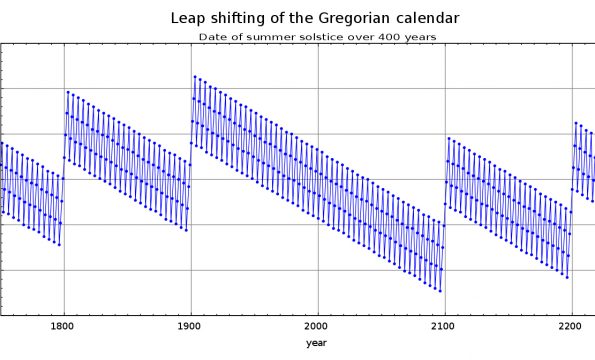CATO Institute, by Steve H. Hanke: For more than 500 years, the most popular and influential book after the Bible was The Golden Legend by Jacobus de Varagine. At the end of the 13th century, Varagine was grappling with how medieval Christians perceived time: He mapped the liturgical calendar and the stories of feast‐day saints associated with it. The book was a bestseller.
Flash forward to today. We now waste a great deal of time fumbling around with the flawed Gregorian calendar. For one thing, new calendars have to be printed ever year. What a waste of both time and money.
But this isn’t the only cost dished up by our Gregorian calendar. Indeed, there are a number of problems and inefficiencies associated with it. Under the Gregorian calendar, the scheduling of the days for holidays, sporting events, and school schedules — to name but a few — must be redone each year. What a waste of time and money.
The Gregorian calendar also causes confusion when it comes to the age‐old idea of “time is money.” For example, to determine how much interest accrues for a wide variety of instruments — bonds, mortgages, swaps, forward rate agreements, etc. — day counts are required. The current calendar contains complexities and anomalies that create day‐count problems.
And there are other financial problems generated by the Gregorian calendar. For example, back in 2013, Apple was caught up in a quarterly reporting fiasco. Following its first‐quarter 2013 earnings announcement, Apple suffered its worst one‐day loss in four years as a result of the company’s failure to meet Wall Street’s expectations. This was largely due to a simple calendar‐generated error — most analysts failed to account for the fact that Apple’s Q1 2013 was one week shorter than the same quarter the year before.
The past 400 years have only seen a handful of cohesive efforts to standardize the modern calendar or iron out the kinks of the Gregorian calendar. The crusade for calendar modernization found one of its most prominent champions in 19th‐century industrialist George Eastman, the founder of the Eastman Kodak Co. Driven by a desire to create a more business‐friendly calendar, he developed the “Eastman plan.” It was one of the first cogent models of a fixed (or permanent) calendar and was designed to eliminate the practical and financial inefficiencies generated by the Gregorian calendar system.
However innovative, the Eastman plan was in many respects crude, failing most crucially to account for and preserve the Sabbath. Like many past attempts at calendar reform, the Eastman plan was doomed by its failure to address religious and cultural concerns. Indeed, one of the major criticisms of such calendar reforms is that they interfered with religious days of rest, which play an integral role in the organization of economic activity, i.e. “the work week.”
To solve the problems generated by the Gregorian calendar and avoid the Sabbath pitfall that plagued George Eastman, we developed the Hanke‐Henry Permanent Calendar (HHPC).
The HHPC offers a comprehensive template for revising the contemporary Gregorian calendar. It adheres to the most basic tenet of a fixed calendar: Every date would fall on the same day of the week every year. So, New Year’s Day would always be a Monday. The year would be divided into four three‐month quarters. The first two months of each quarter would be made up of 30 days; the third would have 31 days.
So, each quarter contains 91 days resulting in a 364‐day year comprised of 52 seven‐day weeks. This is a vital feature of the HHPC: By preserving the seven‐day Sabbath cycle — and so not inserting “extra days” that break up the weekly cycle — it would avoid the major complaints from ecclesiastical quarters that have doomed all other attempts at calendar reform.
There would be a disparity between the necessary length of our calendar (364 days) and that of the astronomical calendar (365.24 days). The HHPC would account for this by tacking an additional week onto every fifth or sixth year. So, there would be an extra seven days added to the calendar in, for example, 2020, 2026, 2032, and so on. This additional week would serve the same purpose as the extra day we count in a leap year in the present system and keep the calendar in line with the seasons.
There is no reason why calendrical change cannot occur more rapidly today. Indeed, with the stroke of a pen, President Donald J. Trump could sign an executive order. With that, the HHPC would become the “Trump Calendar” — a permanent calendar mandated for use by the U.S. government. Why not? After all, this is what Julius Caesar did on January 1, 45 B.C., when the dictator perpetuo introduced the Julian calendar.
Our Comment:
The Hanke-Henry Permanent Calendar preserves the “Sabbath” by placing Sunday as the seventh day of the week. If this calendar change took place, would it cause confusion about the true Sabbath of the Bible and play a role in bringing about Sunday worship laws?
Prophetic Link:
“As the movement for Sunday enforcement becomes more bold and decided, the law will be invoked against commandment keepers. They will be threatened with fines and imprisonment, and some will be offered positions of influence, and other rewards and advantages, as inducements to renounce their faith. But their steadfast answer is: ‘Show us from the word of God our error’—the same plea that was made by Luther under similar circumstances. Those who are arraigned before the courts make a strong vindication of the truth, and some who hear them are led to take their stand to keep all the commandments of God. Thus light will be brought before thousands who otherwise would know nothing of these truths.” Great Controversy, page 607.






Comments